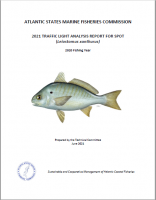
Spot, a favorite catch for many recreational anglers, gets its name from the dark marking behind both gills. It’s a fish with a relatively short lifespan that spawns in the ocean but spends much of its life in estuarine waters, and spot can be found as far north as the Gulf of Maine to as far south as Florida.
In general, commercial harvests of spot have been on the decline since 2001, with recreational catch totals fluctuating throughout the years.
Supporter Spotlight
Spot is managed as a coastwide species because it is found far beyond the boundaries of any one state. The Atlantic States Marine Fisheries Commission, or the ASMFC, oversees multistate management of spot from Delaware to Florida. The ASMFC makes the ultimate management decisions, and then it is up to the individual states to meet the prescribed requirements.

Morgan Paris is the spot and Atlantic croaker species lead at the North Carolina Division of Marine Fisheries. When a fish has a multistate range like spot, collaboration across boundaries is necessary, Paris recently told Coastal Review.
“I wouldn’t say it’s hard,” Paris said. “It’s more just requiring collaboration between states and making sure that you have the open line of data transfer communication, so everyone can get what they need and can process the material correctly.”
The ASMFC’s first spot management plan was implemented in 1987. Since then, the plan has been amended a few times, and in 2014, the plan was altered to include a management technique called the Traffic Light Approach. This technique was updated again in 2020.
The Traffic Light Approach uses harvest and abundance metrics to identify thresholds that trigger certain management actions.
Supporter Spotlight
The 2020 Traffic Light Analysis Review of spot triggered at the 30% threshold. This is categorized as “moderate concern.” The harvest and abundance indices that the Traffic Light Analysis uses were above 30% for two of the previous three years. This triggered two specific management actions.

At a minimum, states have to reduce commercial harvest by 1% of the average state commercial harvest for the previous 10 years, and institute a 50-fish bag limit in the recreational sector. North Carolina’s bag limit is in place, and there’s a commercial season closure in effect from Dec. 10, 2021, through April 4. Management actions are required to be in place for a minimum of two years. According to the ASMFC, work on the next coastwide stock assessment will likely begin next year and be completed in 2024.
“States can still choose to have more strenuous measures in place, but at the bare minimum, you have to follow what ASMFC guidance is putting out,” Paris said.
Related: Analysis: Why NC imposed new limits on spot, croaker
Fortunately for commercial fishermen, the winter months are not the typical time for harvesting spot anyway. This was an intentional decision, said Paris. They wanted the imposed restriction to help the species without negatively impacting fishermen.
“When we did all the crunching of the numbers, we looked at when the effort was concentrated and what time of year will be the best for the actual fishermen,” Paris said.
As to what influence these trends, that’s a little harder to define, said Paris. Research on how different environmental factors may be influencing spot recruitment, or how many young are produced and survive to become juveniles, year over year is something that the ASMFC has listed as a research need.
“The environmental side of it is not a new one, but definitely one that’s becoming more relevant,” Paris said.
Dr. Troy Tuckey, senior research scientist at the Virginia Institute of Marine Science, is particularly interested in what influences population abundance for juvenile fish. For more than a decade, he has been an author on the Juvenile Fish and Blue Crab Trawl Survey, an assessment that helps keep track of fish populations in Chesapeake Bay.

It’s a fisheries-independent survey that goes out every month of the year to take assessments on population abundance of as many fish as possible. The researchers also test location-specific water temperatures, dissolved oxygen, and salinity conditions.
This survey has been conducted regularly since the 1950s, and standardized in terms of methodology since 1988.
“We don’t target any species, we just use the same gear, the same methodology year after year, and assess, measure, identify and count everything that we catch,” Tuckey said.
They use nets with a small mesh in order to help focus on juvenile fish and survey throughout the year to keep track of young populations at different points in time.
Tuckey said they have surveyed spot in areas that recorded average dissolved oxygen, temperature and salinity. This shows that spot tend to gravitate toward conditions that are not too polarized.
Year over year, spot recruitment varies because they spawn in the coastal ocean, which is that area between shore and the continental shelf, and because changes in current or wind may influence how many juveniles end up in the estuaries.
According to Tuckey, it’s not unusual to see big boom-or-bust fluctuations in a species like spot, because of how short their lifespans are. The conditions year to year will directly impact population levels.
Beyond that, there’s still a lot that is unknown about how environmental factors influence spot populations.
It’s really important, said Tuckey, to know how fish respond to environmental factors.
“We need to understand those external factors so that we can manage them better, to make sure that the populations are sustainable for future years,” Tuckey said.







